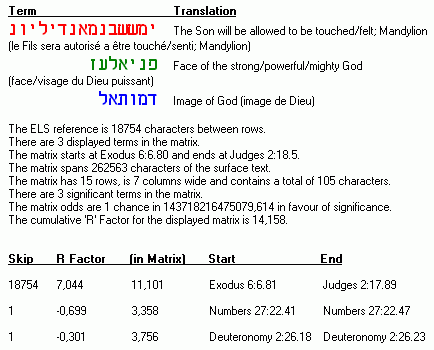
Code by Fab
The Son will be
allowed to be felt; Mandylion.


"...According to Christian legend, the Image of Edessa, (known to Orthodox Christians as the Mandylion, a Byzantine Greek word not applied in any other context), was a holy relic consisting of a square or rectangle of cloth upon which a miraculous image of the face of Jesus was imprinted — the first icon ("image"). According to a legend which developed over many centuries, this image was imprinted into a cloth during a visit of Jesus to the King.
The first record of the existence of a physical image was in the sixth century, in the ancient city of Edessa (now Urfa). The image was moved to Constantinople in the tenth Century. The cloth disappeared from Constantinople during the Crusades, reappearing as a relic in King Louis IX of France's Sainte Chapelle in Paris. It finally disappeared in the French Revolution..."
http://en.wikipedia.org/wiki/Mandylion#Links_with_the_Shroud_of_Turin
"...Writer Ian Wilson has put forward a theory that the object venerated as the Mandylion from the sixth to the thirteenth centuries was in fact the Shroud of Turin, folded in four, and enlcosed in an oblong frame so that only the face was visible.
For support, he refers to documents in the Vatican Library and the University of Leiden, Netherlands, which seem to suggest another image at Edessa. A tenth century codex, Codex Vossianus Latinus Q 69 found by Gino Zaninotto in the Vatican Library contains an eighth-century account saying that an imprint of Christ's whole body was left on a canvas kept in a church in Edessa: it quotes a man called Smera in Constantinople: "King Abgar received a cloth on which one can see not only a face but the whole body" (in Latin: [non tantum] faciei figuram sed totius corporis figuram cernere poteris).[4] This image is apparently not the same as the Mandylion whose widely-disseminated and familiar iconic image is of a face alone; Byzantean reports however mention "one original and two copies"and indicate that the real Mandylion turned out to be a folded whole-body-image with marks of the crucifixion when it was taken out of its reliquary frame - just like the Turin Shroud..."
For more on the Shroud of Turin: